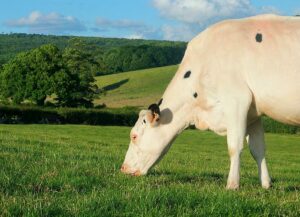María Villagrasa & Fernando Diaz
Calves are born with an immature immune system that keeps developing until about six months after birth. It is for this reason that young calves depend on the passive immunity transferred with their mothers’ colostrum for protection against disease.
Given the high incidence of diarrhea and respiratory diseases that occur in newborn calves, it is important to protect mucous surfaces to try to reduce the risk of infection at this stage, as well as using antimicrobials. From this perspective, immunoglobulin A (IgA) acts as a defense against infection, which, among other functions, prevents viruses and bacteria from adhering to the epithelial surface.
On the other hand, immunoglobulin A (IgA) has an important role in mucous surfaces maintaining the integrity of the epithelial barrier. Immunoglobulin A is the most abundant in secretions, although it represents only 7% of the total immunoglobulins in colostrum.
In mice, IgA promotes the development of non-invasive commensal bacteria and provides protection against enteric pathogens, so if it could stimulate early production in newborns it could become an important defense against pathogenic microbes and promote beneficial bacteria from colonizing mucosal surfaces.
On the other hand, probiotics, non-pathogenic living microorganisms, such as the yeast Saccharomyces cerevisiae boulardii, are known to stimulate the release of IgA in the gut of adult rats.
A group of researchers from the University of Alberta (Canada; Villot et al., 2020) conducted a study to evaluate the ability of newborn calves to produce IgA and analyze the effect of live yeast supplementation on IgA production and microbial colonization in the gut.
A total of 20 Holstein newborn calves up to seven days of age, were assigned to two diets:
- Control: no supplementation
- Treatment: with a Saccharomyces cerevisiae boulardii supplement (SCB)
The animals received two colostrum substitute feedings at 2 and 12 h after birth. The calves were then bottle-fed two feedings of milk replacer daily.
The milk replacer used in this study contained 26% protein, 16% fat and 4.58 Mcal/kg of metabolizable energy dry matter basis. Initially each calf was offered 7.5% of their body weight at birth during the first two days of the experiment and then increased to 8.5% of body weight from day 3 to day 7.
The calves assigned to the treatment group received the same daily amount of yeast (5 g of live SCB) throughout the experiment. Supplementation was added in the first feeding of colostrum and, subsequently, in each morning feeding with milk replacer, which was expected to supply 10 × 109 cfu of SCB per day. The other 10 calves in the control group received no supplementation in any of their feedings during the experiment.
Immune status of newborn calves
Both at 12 h after birth and at a week of life the calves of the two groups had more than 15 mg of IgG/ml in serum, which indicated the transfer of passive immunity was successfully achieved and also showed that supplementation with SCB directly in the colostrum did not affect the absorption of IgG.
With regards to IgA, each calf received 6.0 g of IgA within its first 12 hours of life (3.6 g at 2 h and 2.4 g at 12 h of life). The serum concentration of IgA was not different from 12 h after birth in calves of both groups (0.74 mg/ml). On day 7, serum IgA concentrations were similar for both groups of calves and lower than on the first day (0.28 mg/ml).
In this case the serum concentrations of IgA observed 12 h after birth were due to IgA absorbed directly from colostrum. The significant reduction of serum IgA from day 1 to day 7 was due to the absence of exogenous IgA supply to the animal (IgA originates in colostrum and has a half-life of 2.8 days while the half-life of IgG is 21 days, hence the difference between the observed concentrations of both Ig).
Effects of yeast supplementation on IgA production
At one week of age, calves in the treatment group had higher concentrations of IgA in the ileum (1.98 mg/g) and colon (1.45 mg/g) compared to animals in the control group (1.18 and 0.59 mg/g, respectively).
Similarly, the number of IgA-producing plasma cells per square millimeter was higher in the intestine of the treatment relative to the control group, both in the colon (3.03 vs. 0.60 IgA/mm2 plasma cells producers of IgA) as in the ileum (2.55 vs. 1.0 IgA/mm2 plasma cells producers of IgA).
These results indicate that SCB yeast supplementation improved endogenous production of IgA, which could make treated calves less prone to pathogen entry.
Changes in intestinal bacterial populations
At one week of age the total number of bacteria was lower in the ileum of the treatment group relative to the control (8.59 and 9.02 log10 colonies/g sample), while no differences in jejunum and colon were detected. These results suggest that supplementation with SCB during intestinal colonization in the first few days of life may have a positive effect on calves.
As for the bacterial groups, Lactobacillus spp. was higher in the jejunum of calves of the treatment group, and in these there were higher concentrations of Faecalibacterium prausnitzii in the colon and jejunum compared to the calves of the control group.
Conclusion
Supplementation in the first few days of life with live SCB yeast can stimulate IgA production, which could model a microbial ecosystem beneficial to the gut health of calves.
Reference
Villot, Clothilde & Chen, Yanhong & Pedgerachny, Katie & Chaucheyras-Durand, Frédérique & Chevaux, Eric & Skidmore, Andrew & Guan, Le & Steele, M.A. (2020). Early supplementation of Saccharomyces cerevisiae boulardii CNCM I-1079 in newborn dairy calves increases IgA production in the intestine at 1 week of age. Journal of Dairy Science. 103. 10.3168/jds.2020-18274.
© 2021 Dairy Knowledge Center. All Rights Reserved.










